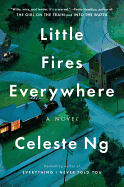Little Fires Everywhere
by Celeste Ng
With a title like Little Fires Everywhere, one expects drama. Beginning with her opening sentence, Celeste Ng (Everything I Never Told You) more than delivers on that promise, immediately igniting the tension and questions that engulf this captivating novel of one family's inner dysfunction and the careless destruction they inflict upon others.
"Everyone in Shaker Heights was talking about it that summer: how Isabelle, the last of the Richardson children, had finally gone around the bend and burned the house down." Little Fires Everywhere opens with Mrs. Richardson--as she's referred to in the novel--wearing her bathrobe and her son's tennis shoes while staring at her smoldering six-bedroom home in affluent Shaker Heights, Ohio.
Among Ng's many strengths as an author is allowing the reader to intuit--even without fully understanding exactly why--that the fire represents a comeuppance of sorts, a fall from grace for Mrs. Richardson, whose dishevelment amid her ruined home places her in stark contrast to her self-perception of the Richardsons being a perfect family in a perfect neighborhood.
On the surface, they seem to be nothing less. Mrs. Richardson is a features reporter for the local newspaper and her husband, Bill, is a partner with a local law firm. The couple have four teenage children: Lexie, Trip, Moody and Izzy, the latter of whom is regarded as "the nutcase" of the family. The other three are popular, athletic and--like their parents--assimilate nicely into the comfortable neighborhood of Shaker Heights, a planned suburban community with "rules, many rules, about what you could and could not do."
Infusing Little Fires Everywhere with an atmosphere of foreboding reflected in the seemingly regimented community, Ng transforms Shaker Heights almost into its own formidable character, one that complements Mrs. Richardson's sense of order and control. "Most communities just happen; the best are planned," the town's motto states. "The underlying philosophy being that everything could--and should--be planned out, and that by doing so you could avoid the unseemly, the unpleasant, and the disastrous." (One's teenage daughter dousing each family member's bedroom with gasoline and striking match after match would undoubtedly rank as something unplanned.)
As she demonstrated in Everything I Never Told You, Ng is a master at having a quiet, unsuspecting character as the driving influence of her fast-paced plot. Izzy, who doesn't measure up to Mrs. Richardson's exacting standards, fulfills that role. Born premature, she will forever serve as a reminder of her mother's infallibility. An impulsive free spirit, Izzy also embodies passion, something Mrs. Richardson once had, but lost long ago. "All her life, she had learned that passion, like fire, was a dangerous thing. It so easily went out of control. It scaled walls and jumped over trenches. Sparks leapt like fleas and spread as rapidly; a breeze could carry embers for miles. Better to control that spark and pass it carefully from one generation to the next, like an Olympic torch. Or, perhaps, to tend it carefully like an eternal flame: a reminder of light and goodness that would never--could never--set anything ablaze. Carefully controlled. Domesticated. Happy in captivity. The key, she thought, was to avoid conflagration."
When Mia Warren and her daughter, Pearl, arrive in Shaker Heights and rent a duplex owned by the Richardsons, they represent a vastly different worldview, one that doesn't conform to Shaker Heights'--or Mrs. Richardson's--rigidity and structure. An avant-garde photographer, Mia is a single mother to Pearl and somewhat of an enigma; she and Pearl move often, have few belongings and are both content with Mia working part-time, minimum-wage jobs while remaining dedicated to her art. The two families' lives begin to intersect even further when Pearl forms a friendship with Lexie and Moody, as well as a romantic entanglement with Trip; Izzy, in turn, becomes a protégé of Mia's. Ng skillfully takes their unlikely connection even further (with devastating, life-changing consequences) when a local, highly publicized adoption case involving a wealthy couple, a single mother and a Chinese American baby prompt Mrs. Richardson to investigate Mia's past, a quest that results in uncovered secrets, betrayal and deception. "One had followed the rules, and one had not. But the problem with rules... was that they implied a right way and a wrong way to do things. When, in fact, most of the time they were simply ways, none of them quite wrong or quite right, and nothing to tell you for sure what side of the line you stood on."
By setting Little Fires Everywhere in the late 1990s, Ng prompts reflection on how a time of rapid technological, political and cultural change (Alta Vista and cell phones were still cutting edge; the president of the United States was facing impeachment for his affair with a White House intern) serves as catalyst for eliciting questions that still resonate and provoke debate decades later. Is motherhood ultimately defined by nature or nurture? Should there be limitations on the biological and emotional lengths one can pursue to fulfill a desire to become a parent? And by what standards do members of a community determine--unspoken or otherwise--what characterizes a "good mother"? To what degree and extent do the qualities of one's children reflect a parent's self-perceived worth?
Ng expertly explored similar themes in her bestselling debut, Everything I Never Told You. With Little Fires Everywhere, she again proves her willingness to ask questions that prompt reflection on the deepest and most fallible aspects of our humanity. --Melissa Firman








_Kevin_Day_Photography.jpg)